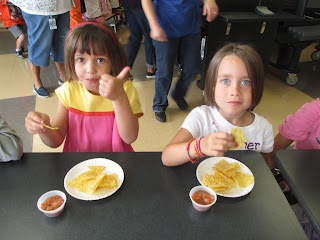Harvest time was so exciting for both first and second graders! Both grades were able to harvest the tomatoes, peppers, and onions that we started from seed last spring.
We have a good understanding now of how the garden is a system through books, observing our school garden and making notes in our scientific notebooks, and our visit to Mr. Leo's garden. We continue to add pictures to the garden timeline in our room that helps us keep a visual of the progression of the plants and the system.
 Thanks to Ms. Zina who prepared salsa for us to enjoy that was made from our harvested vegetables! It was delicious!
Thanks to Ms. Zina who prepared salsa for us to enjoy that was made from our harvested vegetables! It was delicious!

















